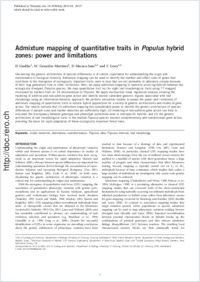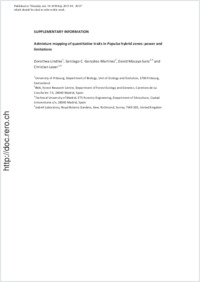Admixture mapping of quantitative traits in Populus hybrid zones: power and limitations
- Lindtke, Dorothea Unit of Ecology and Evolution, Department of Biology, University of Fribourg, Switzerland
- González-Martínez, S. C. INIA, Forest Research Centre, Department of Forest Ecology and Genetics, Madrid, Spain
- Macaya-Sanz, David INIA, Forest Research Centre, Department of Forest Ecology and Genetics, Madrid, Spain - Technical University of Madrid, ETS Forestry Engineering, Department of Silviculture, Spain
- Lexer, Christian Unit of Ecology and Evolution, Department of Biology, University of Fribourg, Switzerland - Jodrell Laboratory, Royal Botanic Gardens, Kew, Richmond, UK
-
17.07.2013
Published in:
- Heredity. - 2013, vol. 111, no. 6, p. 474-485
English
Uncovering the genetic architecture of species differences is of central importance for understanding the origin and maintenance of biological diversity. Admixture mapping can be used to identify the number and effect sizes of genes that contribute to the divergence of ecologically important traits, even in taxa that are not amenable to laboratory crosses because of their long generation time or other limitations. Here, we apply admixture mapping to naturally occurring hybrids between two ecologically divergent Populus species. We map quantitative trait loci for eight leaf morphological traits using 77 mapped microsatellite markers from all 19 chromosomes of Populus. We apply multivariate linear regression analysis allowing the modeling of additive and non-additive gene action and identify several candidate genomic regions associated with leaf morphology using an information-theoretic approach. We perform simulation studies to assess the power and limitations of admixture mapping of quantitative traits in natural hybrid populations for a variety of genetic architectures and modes of gene action. Our results indicate that (1) admixture mapping has considerable power to identify the genetic architecture of species differences if sample sizes and marker densities are sufficiently high, (2) modeling of non-additive gene action can help to elucidate the discrepancy between genotype and phenotype sometimes seen in interspecific hybrids, and (3) the genetic architecture of leaf morphological traits in the studied Populus species involves complementary and overdominant gene action, providing the basis for rapid adaptation of these ecologically important forest trees.
- Faculty
- Faculté des sciences et de médecine
- Department
- Département de Biologie
- Language
-
- English
- Classification
- Biological sciences
- License
-
License undefined
- Identifiers
-
- RERO DOC 32959
- DOI 10.1038/hdy.2013.69
- Persistent URL
- https://folia.unifr.ch/unifr/documents/303365
Other files
Statistics
Document views: 137
File downloads:
- pdf: 132
- Supplementary material: 174

